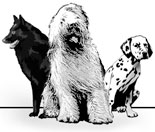Bing Blog #12
| Trainer’s Addiction: Freeshaping -- January 26, 2006 I have mentioned the concept of “freeshaping” in previous blogs but didn’t expand on it. Since I’ve had a few requests to do so, I’ll take that opportunity now to explain more about freeshaping and why I love it so much. Most of the time that we spend training our dogs, we are teaching them something in particular; sit, down, stay, wait, come. We have specific goals in mind, and we work on them until the dog accomplishes a certain level of consistency in his response. But there are times when I want to work with my dog just for the sake of working with him. I want to engage my dog in the activity of LEARNING. I want to enjoy the give-and-take of behavior and reward. As a clicker trainer, I ask my dogs to think about things, to offer behaviors, to watch me and interact with me, rather than to wait for me to tell them what to do all the time. In Bingblog #4, I referred to Bing as being “a remarkably operant fellow”; it’s this process to which I’m referring. Clicker training utilizes operant conditioning, where the dog is actively figuring out what it takes to get ‘the good stuff’ (whatever is rewarding to him). Using the phrase ‘he’s operant’ is actually an incorrect term, but one that’s become slang in the field. What we mean is that he is ‘behaving in a very operant manner’. Bing has learned about offering behaviors. He learned this whole process through freeshaping. In order to teach this, he had to know that ‘click’ means ‘treat’. You can teach this as simply as dumping a bunch of treats on the ground, and as he picks each one up with his mouth, click (classically conditioning the click and treat). Or, you can ask your dog to sit, and when he does, click and treat. Or, you can hold out the palm of your hand, and when he goes to sniff it, click and treat him. Do this for a series of repetitions, and your dog will start to associate the click with a treat. In these last two examples, the dog is behaving in an operant manner; he is figuring out that by offering some behavior, he hears the click and gets the treat. Once Bing understood about the clicker, I started to take him into a room away from the other dogs, and sit with him, the clicker, and a bunch of treats. I’d start to click and treat anything he did. Since he had recently learned that sitting meant that good things happened, he offered me a sit (I did NOT ask for it). I promptly clicked and treated him for that. Of course, being so young, he naturally stood up to eat that treat, so all I had to do was wait for him to offer another sit, and I clicked and treated him for that. We did this a few times, maybe three or four. The next time he offered a sit, however, I didn’t click. He looked at me intensely and expectantly, and when the click was not forthcoming, he threw a paw at me. I clicked and treated that. He offered that behavior a few times, and after the third or fourth time, as he was throwing his paw at me, I said, ‘wave!’, then clicked and treated. I had gotten a behavior a bunch of times, and I was starting to label it. Once I had labeled it consistently enough, I could use that word as a command or a cue. For behaviors that are this simple, the actual process is called, ‘capturing’. ‘Freeshaping’ technically refers to the rewarding of successive approximations of a behavior that are offered without prompt. You have in mind a particular behavior that you want to teach, and you start to reward anything that the dog offers. You only want to click and treat each behavior once or twice, and hold out for something a little more the next time. This really is an art, as you have to have a feeling for the frustration tolerance of the dog. If you hold out for too much, the dog will likely get frustrated and give up. But if you reward a behavior too many times, you will get stuck with that behavior because the dog will think that that is the final desired behavior. Here’s an example. I want to freeshape Bing to lay down with his head down between his paws. I take him into a quiet room and let him know that we are going to play the game by showing him my clicker and treats. He offers a sit, so I click and treat. He stands up to get the treat (I usually toss the treat away from him so he has to move away and offer the behavior again), then offers another sit. This time I don’t click it, so he lays down. I click and treat. He offers another sit, but I’ve already rewarded something more than that, so I don’t click it. He offers another down, and I click and treat. Why? Because I want him to understand that this was a step in the right direction. I toss the treat away, he comes back, sits (no click and treat), downs, (no click and treat this time), then after waiting a few seconds, barks at me. I do not respond to this at all. It’s not part of the response I’m looking for. Seeing that barking hasn’t helped, he swats a paw on the floor. I don’t respond to this. He barks again. I don’t respond to this. He is clearly becoming frustrated. He sniffs the ground. I click and treat. One step closer! He looks at me and barks again; no response. Then he puts his head down on the floor between his paws. I click and jackpot with a pile of treats! After this he will offer a bunch more of different things, but it won’t take him long to figure out that putting his head down is ‘the ticket’. I will want to see him offer this behavior a few more times over a few different training sessions before I start to add a cue to it, just to make sure that he is aware that THIS is the particular behavior I’m looking for. A few things of interest to mention here; Bing’s floor sniffing wasn’t a total coincidence. He was engaging in a calming signal! Had he not done this, I would have tried to find anything I could have clicked and treated at this point because I knew that I was losing him. He is very young and doesn’t have a huge attention span, nor had he played the game before. Dogs who are more experienced with freeshaping can often handle more frustration because they know that if they continue to offer behaviors they’ll eventually hit on the one I want. So here, I was pretty lucky that he offered something close to what I wanted. Freeshaped behaviors become very strong behaviors. They almost never go away; once you teach it, it’ll be there forever! So be careful what you decide to capture or freeshape! In addition, any time your dog wants your attention, or sees you waiting for his attention, he will offer you all his freeshaped behaviors in his book….really fun to watch! Ali
|
||



